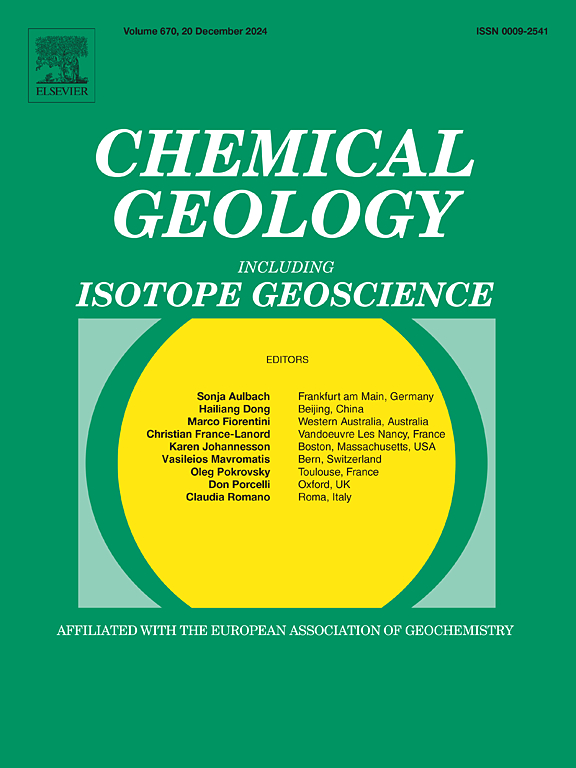Assessing the contribution of Good's buffers to laboratory experiments on Fe(II)aq-induced ferrihydrite transformation
IF 3.6
2区 地球科学
Q1 GEOCHEMISTRY & GEOPHYSICS
引用次数: 0
Abstract
Numerous previous experiments on Fe(II)aq-induced Fe(III) oxide transformation used Good's buffers to maintain pH. However, Good's buffer has previously been found to directly complex with the mineral surface and the metals in solution, and indirectly influence the interactions between Fe(II)aq and Fe(III) oxides by changing the mineral surface properties. So far, to what extent the presence of buffer unintentionally affects the experimental results remains unclear. Herein, this study evaluated the potential contribution of three typical Good's buffers, MES, MOPS and HEPES, to Fe(II)aq-induced ferrihydrite transformation using batch experiments with 10 mM ferrihydrite, 1 mM Fe(II)aq, 0–50 mM buffer and 0–0.1 M NaCl at pH 6.0–7.5. The results showed none of the tested buffers could adsorb on ferrihydrite. The extents and products of ferrihydrite transformation in the presence of 0–50 mM buffer were similar at any given pH within 24 h. However, the extents of ferrihydrite transformation with 10–50 mM buffer were significantly (p < 0.05) higher than those with 0–1 mM buffer after 72 h. The enhanced transformation with higher buffer concentrations can be attributed to the elevated ionic strength, which raised initial surface loading of Fe(II) on ferrihydrite. The comparison between experiments with and without background electrolyte (NaCl) further confirmed that high ionic strength could promote ferrihydrite transformation with the effect becoming more and more evident over time. Our data systematically assessed the contribution of Good's buffers to laboratory experiments on Fe(II)aq-induced Fe(III) oxide transformation and provide important reference for similar experiments in the future.
评估古德缓冲液对铁(II)aq诱导水合铁转变的实验室实验的贡献
之前关于Fe(II)aq诱导的Fe(III)氧化物转化的许多实验都使用Good’s缓冲液来维持ph。然而,Good’s缓冲液已经被发现直接与矿物表面和溶液中的金属络合,并通过改变矿物表面性质间接影响Fe(II)aq和Fe(III)氧化物之间的相互作用。到目前为止,缓冲液的存在在多大程度上无意地影响了实验结果尚不清楚。本研究利用10 mM水合铁、1 mM Fe(II)aq、0-50 mM缓冲液和0-0.1 M NaCl在pH 6.0-7.5条件下的批处理实验,评估了MES、MOPS和HEPES三种典型的Good’s缓冲液对铁(II)aq诱导水合铁转化的潜在贡献。结果表明,所测缓冲液均不能吸附水合铁。0-50 mM缓冲液存在时,24 h内水合铁的转化程度和产物在任何给定pH下都是相似的。而10-50 mM缓冲液存在时,水合铁的转化程度显著(p <;缓冲液浓度越高,离子强度越高,铁(II)在水合铁上的初始表面负载越高。通过添加和不添加背景电解质(NaCl)的实验对比,进一步证实了高离子强度可以促进水合铁的转化,且随着时间的推移,这种作用越来越明显。我们的数据系统地评估了Good缓冲液对Fe(II)aq诱导Fe(III)氧化物转化的实验室实验的贡献,为今后类似的实验提供了重要的参考。
本文章由计算机程序翻译,如有差异,请以英文原文为准。
求助全文
约1分钟内获得全文
求助全文
来源期刊

Chemical Geology
地学-地球化学与地球物理
CiteScore
7.20
自引率
10.30%
发文量
374
审稿时长
3.6 months
期刊介绍:
Chemical Geology is an international journal that publishes original research papers on isotopic and elemental geochemistry, geochronology and cosmochemistry.
The Journal focuses on chemical processes in igneous, metamorphic, and sedimentary petrology, low- and high-temperature aqueous solutions, biogeochemistry, the environment and cosmochemistry.
Papers that are field, experimentally, or computationally based are appropriate if they are of broad international interest. The Journal generally does not publish papers that are primarily of regional or local interest, or which are primarily focused on remediation and applied geochemistry.
The Journal also welcomes innovative papers dealing with significant analytical advances that are of wide interest in the community and extend significantly beyond the scope of what would be included in the methods section of a standard research paper.
 求助内容:
求助内容: 应助结果提醒方式:
应助结果提醒方式:


